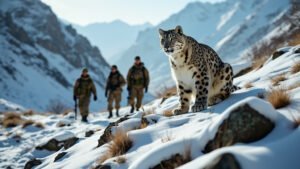Introduction
Scientific research plays a crucial role in the conservation of snow leopards, a vulnerable species found in mountainous regions across Central Asia. From tracking their movements to understanding their genetics and habitats, research provides essential data to develop effective conservation strategies
This article will explore how research helps monitor snow leopards in the wild, the role of genetic studies in conservation, and the importance of habitat mapping. It will also cover how research contributes to reducing human-snow leopard conflicts, ensuring the survival of this iconic predator
How Research Helps Track Snow Leopards in the Wild
Scientific research has made significant advances in tracking snow leopards, an elusive species often referred to as “ghosts of the mountains” due to their secretive behavior and remote habitats
Tracking is essential for understanding snow leopard movement patterns, habitat use, and interactions with other wildlife and humans. By gathering data on their behavior, researchers can develop strategies to protect their natural environment, ensure their survival, and reduce human-animal conflicts
Tracking snow leopards is no easy task due to the species’ wide range and rugged terrain. However, recent innovations in technology, like satellite and GPS collars, have made it more feasible to monitor their activities accurately over long periods and vast distances
In addition to location data, researchers can now gather valuable insights into migration patterns, hunting behavior, and territory sizes
Technologies Used in Snow Leopard Tracking
Several technologies have revolutionized the study of snow leopards. Among them, GPS collars are the most common tool for tracking, enabling scientists to collect real-time data on an individual snow leopard’s movements
These collars send signals to satellites, which in turn relay the data back to researchers, allowing them to pinpoint the animal’s exact location. This information is crucial for determining critical areas of habitat use, hunting zones, and travel corridors. GPS collars also help identify risks, such as encroaching human activities that could lead to conflict
Another important tool is camera traps. These motion-activated cameras are set up in locations where snow leopards are likely to pass. When a snow leopard triggers the camera, it captures images that can be analyzed to understand population density, behavior, and habitat use
Camera traps have been widely used in regions such as the Himalayas and the Altai Mountains, offering researchers an inexpensive and non-invasive way to monitor populations
Importance of Satellite and GPS Collars
Satellite and GPS collars have provided the most detailed data about snow leopards to date. Research led by the Snow Leopard Trust has utilized these collars to track snow leopards in the mountains of Mongolia, Kyrgyzstan, and India, providing valuable insights into their movements and range
For example, one study conducted by Koustubh Sharma and his team in Mongolia found that snow leopards traveled more than 27 miles a day across rugged mountain terrain, an unexpected finding that altered conservation efforts to protect larger areas of habitat
These collars have also helped to map critical corridors used by snow leopards to move between different parts of their range. Identifying these travel corridors is key to preventing habitat fragmentation, which can severely limit the population’s genetic diversity and survival prospects
Scientific Impact of Snow Leopard Movement Data
Tracking data has reshaped our understanding of snow leopard behavior and ecology. For instance, a study by McCarthy et al. (2017) found that snow leopards have much larger territories than previously thought, with males occupying territories over 77 square miles
This territorial data has been instrumental in shaping new conservation policies, ensuring that protected areas are large enough to sustain viable populations of snow leopards. Furthermore, the tracking of females has revealed key breeding areas that need special protection from human activity
Movement data has also revealed the overlap between snow leopard territories and human settlements, highlighting the importance of managing human-snow leopard interactions
This has led to initiatives such as installing predator-proof enclosures for livestock and promoting eco-tourism, which provides local communities with a financial incentive to protect snow leopards instead of viewing them as a threat to their livelihood
Tracking technology, in combination with ground research and local knowledge, continues to play a crucial role in snow leopard conservation efforts
By studying their movements, researchers are helping to build a clearer picture of how these elusive cats survive and what can be done to ensure their long-term survival
The Role of Genetic Studies in Snow Leopard Conservation
Genetic studies are a critical component of snow leopard conservation, providing insights into the species’ overall genetic health, population structure, and evolutionary history. Understanding the genetic diversity of snow leopards is essential for creating effective conservation strategies, particularly as these animals face threats from habitat fragmentation, poaching, and climate change
Genetic research allows scientists to identify isolated populations, detect inbreeding, and manage both wild and captive snow leopard populations with a goal of preserving genetic diversity and reducing extinction risks
By analyzing DNA samples from wild and captive snow leopards, researchers can trace population lineages, uncover evolutionary adaptations, and assess how different populations interact
This information is used not only to protect existing snow leopard populations but also to guide conservation actions such as breeding programs and habitat restoration
Population Genetics and Genetic Diversity
Genetic diversity is essential for the long-term survival of any species, as it helps populations adapt to environmental changes and resist diseases
In snow leopards, genetic studies have shown that populations are often isolated due to the rugged mountain terrain they inhabit, leading to limited gene flow between different groups. This isolation can reduce genetic diversity, making populations more vulnerable to diseases and environmental changes
Research led by Janečka et al. (2017) examined the genetic diversity of snow leopards across their range, analyzing DNA from hair, scat, and tissue samples collected in the wild
The study revealed that although snow leopard populations are widely dispersed across Central Asia, there is significant genetic variation between regional populations. However, some smaller, isolated populations were found to have lower genetic diversity, raising concerns about their long-term viability
Conservation efforts aim to increase gene flow between these isolated groups by protecting migration corridors and minimizing habitat fragmentation
By maintaining genetic diversity, researchers hope to enhance the species’ ability to survive in changing environments, which is especially important given the increasing threats posed by climate change
Identifying Vulnerable Populations Through Genetics
One of the key uses of genetic research in snow leopard conservation is identifying populations that are at risk of becoming genetically isolated
Genetic markers allow scientists to trace relationships between individuals and populations, revealing how gene flow is restricted by geographic barriers like mountain ranges or human developments
For example, in the Himalayas, genetic studies have shown that certain snow leopard populations are becoming increasingly fragmented due to the construction of roads and infrastructure, which limits their ability to migrate and breed with other groups
By identifying these at-risk populations, conservationists can focus their efforts on preserving or restoring critical habitats and migration corridors
This targeted approach helps maintain genetic diversity across the entire species, reducing the risk of localized extinctions and ensuring that populations remain resilient in the face of environmental changes
Using Genetics to Prevent Inbreeding in Captive Programs
Genetic studies are also fundamental in managing snow leopard breeding programs in captivity. Captive breeding programs are designed to preserve the species while maintaining high levels of genetic diversity, which is crucial for ensuring that future generations are healthy and viable
Inbreeding, or mating between closely related individuals, can lead to reduced fitness, increased susceptibility to diseases, and other genetic disorders, so avoiding it is a priority in such programs
By using genetic data, researchers can track the relatedness of individuals within captive populations and design breeding programs that maximize genetic diversity. For example, the European Endangered Species Program (EEP) for snow leopards employs genetic information to carefully pair individuals for breeding, ensuring that each cub born in captivity has the highest possible genetic fitness
Genetic research also helps monitor how well the captive population reflects the genetic diversity of wild snow leopards, allowing zoos and conservation centers to make informed decisions about breeding, reintroduction, and population management
Furthermore, genetic information can be used to match captive snow leopards with wild counterparts in reintroduction efforts, ensuring that individuals released into the wild have the necessary genetic diversity to thrive and integrate with existing populations. This practice helps mitigate the risk of inbreeding in both captive and wild populations
How Habitat Mapping Contributes to Snow Leopard Protection
Habitat mapping plays an essential role in snow leopard conservation by identifying critical areas where the species can thrive
These maps, developed through extensive field research and satellite data, help conservationists understand where snow leopards live, how they move through their environment, and which areas are under threat from human activities
By mapping snow leopard habitats, scientists can prioritize areas for protection, restoration, and management, ensuring that the species has access to suitable environments for hunting, breeding, and migrating
Habitat maps are also crucial for understanding the impact of human encroachment, such as mining, deforestation, and infrastructure development, which can fragment snow leopard habitats. These maps provide a foundation for creating wildlife corridors and protected areas, ultimately shaping conservation policies at national and international levels
Mapping Snow Leopard Ranges and Migration Patterns
One of the key uses of habitat mapping is to delineate the range of snow leopard populations. Snow leopards are wide-ranging animals, with individual territories often covering over 77 square miles, as shown by studies like McCarthy et al. (2017)
Tracking snow leopard movements through GPS collars and satellite imagery allows researchers to map these territories, identifying the areas most crucial for their survival. These range maps are used to determine how snow leopards interact with their environment, their prey, and human communities
Migration patterns are another important aspect of habitat mapping. Snow leopards need to move across vast landscapes to find food, mates, and suitable breeding grounds. However, their migration routes can be interrupted by human developments, leading to fragmented populations and reduced genetic diversity
By mapping these migration corridors, conservationists can work to maintain or restore connectivity between habitats, ensuring that snow leopards can continue to migrate without encountering barriers like roads, fences, or settlements
In 2020, Lovari et al. published a study mapping snow leopard habitats in the Himalayas, revealing how habitat fragmentation was affecting population movement and gene flow
Their research was instrumental in identifying key areas where conservation action was necessary to protect migration routes and ensure genetic exchange between isolated populations
Assessing Habitat Quality and Human Encroachment
Habitat mapping also allows researchers to assess the quality of snow leopard habitats and how they are affected by human activities. The quality of a habitat is determined by several factors, including the availability of prey, access to water, and the presence of safe dens for breeding
Researchers use mapping to locate these critical resources and monitor how they are impacted by threats such as overgrazing by livestock, illegal hunting of prey species, and human settlement expansion
In areas where human encroachment is a significant threat, habitat maps help conservationists develop mitigation strategies. For example, if a critical snow leopard habitat is near a rapidly expanding village, conservationists may work with the local community to promote sustainable land use, such as creating predator-proof enclosures for livestock or establishing buffer zones between human settlements and key snow leopard areas
Mapping can also highlight areas where human activities, like mining or road construction, need to be regulated to avoid disrupting important snow leopard habitats
For instance, in the Pamir Mountains of Central Asia, habitat mapping revealed the encroachment of mining activities into snow leopard territory, prompting action from conservation groups to advocate for stricter environmental regulations in the region
These efforts helped to secure additional protections for key snow leopard habitats
The Use of Habitat Data in Creating Protected Areas
Perhaps the most direct application of habitat mapping is in the establishment and management of protected areas
By identifying the regions where snow leopards are most likely to thrive, conservationists can designate these areas as national parks, wildlife reserves, or conservation zones, where human activities are restricted to protect the species and its environment
Habitat mapping has been instrumental in expanding existing protected areas and creating new ones. For example, the Snow Leopard Trust has worked with local governments in Mongolia to use habitat maps to expand the Tost Nature Reserve, ensuring that it covers a larger portion of critical snow leopard habitats
Similarly, in Kyrgyzstan, habitat maps were used to establish new protected areas in the Tian Shan Mountains, where snow leopard populations are at risk due to poaching and habitat loss
Moreover, these protected areas are often designed with buffer zones, where human activities are regulated to reduce the risk of conflict between snow leopards and local communities. Habitat maps are essential for identifying these buffer zones and ensuring that they are placed in areas that will have the most significant conservation impact
How Research Helps Mitigate Human-Snow Leopard Conflicts
Human-snow leopard conflicts are one of the most pressing challenges for snow leopard conservation. As human populations expand into snow leopard habitats, encounters between people and these big cats become more frequent, often resulting in livestock losses for local communities
In retaliation, snow leopards are sometimes killed by herders protecting their livelihoods. Research plays a crucial role in understanding the dynamics of these conflicts and developing solutions that benefit both snow leopards and the people living alongside them
Through field studies, data collection, and behavioral research, scientists can identify patterns of conflict, high-risk areas, and factors that increase the likelihood of snow leopards preying on livestock
This information informs strategies to reduce conflicts, such as community-based conservation programs, improved livestock management practices, and the use of non-lethal deterrents
Understanding Conflict Zones Through Data
Scientific research has been instrumental in identifying “conflict hotspots” where snow leopards are most likely to prey on livestock
Studies have shown that these conflicts often occur in areas where natural prey populations have been depleted due to overhunting or habitat degradation. Without enough wild prey, snow leopards are forced to target domestic animals, leading to an increase in attacks on livestock
By using GIS (Geographic Information Systems) and other mapping technologies, researchers can overlay data on snow leopard movements, livestock grazing patterns, and human settlements to identify high-risk areas
In a study conducted in Nepal, researchers used GPS collar data to track snow leopard movements in relation to livestock grazing zones, revealing that most attacks occurred within a narrow buffer zone near human settlements
This kind of data allows conservationists to focus their efforts on specific regions where conflict is most likely to occur, implementing targeted solutions that address both the needs of local communities and the conservation of snow leopards
Behavioral Studies in Conflict Resolution
Understanding snow leopard behavior is key to developing effective conflict mitigation strategies. Behavioral studies have provided insights into why snow leopards target livestock and what factors influence their hunting patterns
For instance, research has shown that snow leopards are more likely to attack livestock when their natural prey populations are low or during harsh winter months when hunting is more challenging
By analyzing snow leopard behavior, researchers can predict when and where conflicts are most likely to arise. This information can then be used to guide conservation efforts, such as reducing livestock grazing in high-risk areas during vulnerable times or improving herding practices to minimize the chances of snow leopards entering grazing zones
One study conducted in the Altai Mountains revealed that snow leopards tend to avoid human settlements during the day but become more active in the evening, increasing the risk of livestock predation at night
Based on this research, local communities were advised to confine their animals in predator-proof enclosures at night, significantly reducing livestock losses
The Role of Research in Developing Non-Lethal Deterrents
Non-lethal deterrents are one of the most effective tools for reducing human-snow leopard conflicts, and scientific research has played a key role in developing and testing these solutions
Predator-proof livestock pens, for example, have been shown to dramatically reduce snow leopard attacks on herds. These enclosures are designed to prevent snow leopards from gaining access to livestock, offering a simple but effective way to protect animals without harming the predator
In the Himalayas, the Snow Leopard Trust has partnered with local herders to build predator-proof corrals based on research showing that most livestock predation occurs at night when animals are left unsupervised
Studies have found that herders using these enclosures experienced an 80% reduction in livestock losses, helping to decrease retaliatory killings of snow leopards
Other non-lethal deterrents include the use of guard dogs and acoustic devices that scare snow leopards away from grazing areas. Research has shown that the presence of large guard dogs can significantly reduce the risk of snow leopard attacks, as the animals are more likely to avoid areas where they perceive a threat
In Mongolia, the introduction of Tibetan mastiffs as guard dogs has helped protect livestock from snow leopards and other predators
Scientific studies have also explored the use of compensation programs, where herders are reimbursed for livestock losses caused by snow leopards
Research has shown that these programs, combined with community engagement and education, can help build local support for snow leopard conservation by reducing the financial burden on herders
By working closely with local communities, researchers have been able to develop practical, science-based solutions that mitigate conflicts while protecting snow leopards. These efforts are critical for ensuring the long-term survival of snow leopards in areas where they share territory with humans
Conclusion
Scientific research has become an indispensable tool in the conservation of snow leopards. Through tracking technologies like GPS collars and satellite data, researchers can monitor snow leopard movements across their vast territories, providing crucial insights into their behavior, migration patterns, and habitat use
Genetic studies play an equally important role by helping identify isolated populations, preventing inbreeding, and guiding both wild and captive breeding programs to ensure the species’ long-term genetic health
Additionally, habitat mapping allows scientists to protect the most critical snow leopard environments, understand the effects of human encroachment, and create effective conservation strategies such as protected areas and wildlife corridors
Research into human-snow leopard conflicts has also led to practical solutions like predator-proof enclosures and non-lethal deterrents that mitigate conflicts while safeguarding both local livelihoods and snow leopard populations
Overall, scientific research informs nearly every aspect of snow leopard conservation, from protecting habitats and monitoring populations to reducing human-animal conflicts and ensuring the species’ survival for future generations. By continuing to leverage science-based solutions, conservationists can better safeguard this elusive and endangered species











